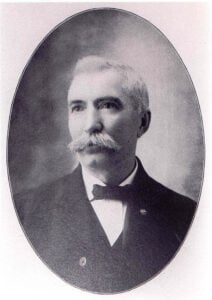Capture the Flag: Corporal George W. Reed
During the U.S. Civil War, many Medals of Honor were awarded for capturing the enemy's flag. George W. Reed was the recipient of one such award on September 6, 1864,…

Petersburg, Virginia, sat a mere 25 miles from Richmond. Its road system and complex of railroads made it a major supply center for the Confederate capital of Richmond. Ulysses Grant, commanding general of the Union Army, recognized the city’s importance and, after the Battle of Cold Harbor, moved his troops southward with an eye to cutting off the major supply lines to Richmond by capturing Petersburg. If successful, Grant reasoned, Confederate General Robert E. Lee would be forced to move out of Richmond, making the capital city vulnerable. On June 15, 1864, Grant launched his attack on Petersburg. The next four days would see fierce fighting, with Grant’s troops failing in their mission. The lack of success led Grant to initiate a siege of the city. The result would be nearly 10 months of untold hardship for the citizens of Petersburg, accompanied by 70,000 casualties between the two armies. It would be the longest single military event of the Civil War. During those 10 months, Grant wore the Confederate Army down, methodically taking control of railroads and roads one after another. By April 2, 1865, Lee was forced to abandon Petersburg. He would surrender at Appomattox Courthouse just a week later, ending the South’s four-year effort to secede from the Union.
By James Gindlesperger, historical author
Sergeant John Brosnan of the 164th New York Infantry had had his fill of war. Still only 18 years old, he was a two-year veteran, having lied about his age to enlist at the age of 16 in New York City. Born in Ireland, he had fought at such places as Spottsylvania Courthouse, North Anna River, Totopotomoy, and Cold Harbor, and now, on June 16, 1864, he was fighting at Petersburg. Most of the regiment’s officers had been killed or wounded, and Brosnan found himself in command of his company, Company E, a role he did not particularly want or feel qualified to handle.

Company E had been a part of several attempts to advance, each time being driven back. Each unsuccessful charge had seen the company shrink in fighting strength, as man after man had fallen victim to the Rebel forces. The Union line was in danger of collapsing.
With another charge ordered, Brosnan jumped to his feet and relayed the command to his company. The charge began, but Confederate fire quickly brought it to a halt, with Company E being forced into a small gully, where they took a stand. Brosnan and his men, by now nearly exhausted, fought desperately until daylight faded and it was too dark to continue the clash. Before resting, however, they constructed crude breastworks that would shield them from any random shots that might come their way. In the morning, they could be used as a temporary fortification until ordered to either retreat or charge once again.
Early the next morning, with the skies just beginning to lighten, Brosnan was alerted to the unmistakable sounds of a wounded soldier. After listening to the man’s cries for several minutes, Brosnan was able to garner a rough idea of where the man lay. Already, the moaning was getting weaker, and Brosnan decided it didn’t really matter if the man was wearing a blue uniform or a gray one. Although the term “no man’s land” would not be uttered for another 50 years, the description could already apply to the area the painful cries were emanating from. Despite the dangerous location, he made the decision to attempt a rescue.
As the gunfire from both sides began to escalate, Brosnan slowly made his way to where he thought the wounded man would be. Crouching to avoid the balls that zipped past his head, he soon saw the man lying under some brush, where he had taken cover. Not only was he a Union soldier, Brosnan realized he actually knew the man, Corporal Michael Carroll of Brosnan’s own Company E.
Seeing his rescuer approach, Carroll drew on all his remaining strength to call out to Brosnan, “For God’s sake, Sergeant, lie down or you will be killed.” Performing a cursory assessment of Carroll’s wounds, Brosnan knew he didn’t have much time. He gingerly lifted Carroll and carried him as best he could. Still crouching to avoid enemy fire, he laboriously carried his corporal in the direction of the breastworks. Before arriving, however, a Confederate ball found its mark, striking Brosnan in the left arm, just above the elbow. The wound left his arm unusable, and with only one arm it made the task of rescuing Carroll all the more difficult. Eventually, however, he reached the safety of the breastworks thrown up by his company the night before.
Unfortunately, Brosnan’s heroic efforts would go for naught, as Carroll would not survive his wounds. Further, his own wound was so severe that his arm had to be amputated, and he was medically discharged on February 7, 1865. On January 18, 1894, Brosnan’s bravery was officially recognized when he received the Medal of Honor for his actions at Petersburg. His citation read: Rescued a wounded comrade who lay exposed to the enemy’s fire, receiving a severe wound in the effort.
Sergeant John Brosnan lived for 57 years after receiving his wound at Petersburg. He died on August 7, 1921, and was buried in Holy Cross Cemetery in Brooklyn, New York.
